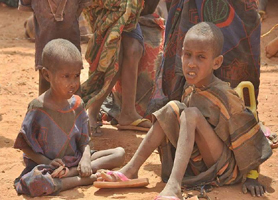 While aid donations have been rising in the UK, studies suggest that there has been a fall in the quality of public engagement. Lilie Chouliaraki critically examines this paradox in her new book ‘The ironic spectator. Solidarity in the age of post-humanitarianism’. There, she shows that new forms of humanitarian communication, which she terms ‘post-humanitarian’, signal that we are moving away from the moral values of the past: care for the other and social justice. She argues that we need to bring those who suffer back into the picture and to be reminded, subtly but constantly, as to why solidarity with distant others still matters.
While aid donations have been rising in the UK, studies suggest that there has been a fall in the quality of public engagement. Lilie Chouliaraki critically examines this paradox in her new book ‘The ironic spectator. Solidarity in the age of post-humanitarianism’. There, she shows that new forms of humanitarian communication, which she terms ‘post-humanitarian’, signal that we are moving away from the moral values of the past: care for the other and social justice. She argues that we need to bring those who suffer back into the picture and to be reminded, subtly but constantly, as to why solidarity with distant others still matters.
There are two questions I seek to answer in my book, The Ironic Spectator. The first is a general question about how we communicate the suffering and vulnerability of others, something the field of development has struggled over for decades. The debate has been there forever – and it is a moral and political rather than just an aesthetic debate – but I thought we weren’t getting satisfactory responses. I felt we needed to revisit those questions, approaching the topic from a fresh perspective.
The second question – and the main trigger for the book – was a recent trend in charity communication. New forms of campaigning have emerged, which are very advanced in the way they market international humanitarian brands, and I was intrigued by these new campaigns’ clean aesthetic, their total focus on the consumer and their suppression of the sufferer in their messages. Because they rely on a set of aesthetic choices that move away from traditional humanitarian tropes of representing vulnerable others, both negative and positive, I termed these messages ‘post-humanitarian’ and tried to understand what these post-humanitarian messages tell us about the ways we engage with human vulnerability, today.
In the past, negative portrayals – which emerged after colonialism but are still seen today – show sufferers in pure destitution, as passive and as lacking agency; sick children lying down, helpless and emaciated for example (see below). They try to illicit feelings of guilt in viewers to urge them to donate.
Positive portrayals emerged in response to the negative ones, as part of a growing critique over how we depict Africa in the mid-1980s around the time of Live Aid. This imagery reversed the negative stereotype , but created its own stereotype in that it was all too positive about the predicament of human vulnerability (see below). Campaigners were well-intentioned in wanting to foster more empathy and identification with victims, but the result was that you almost couldn’t see the need to donate as there seemed to be nothing different between the supposed sufferers and viewers.

The post-humanitarian aesthetic is a response to those two problematic forms of representation. Charities asked ‘if neither negative nor positive imagery works, what can we do?’ The answer they came up with was simply to avoid the impossible challenges of representing sufferers altogether and focus, instead, on those who give, treating citizens as consumers in the same way as any market brand does. ActionAid’s Find Your Feeling, Oxfam’s Be Humankind or the very successful Kony2012 campaign are all examples of this new aesthetic style of humanitarian communication.

There are two main consequences of this shift. Firstly, it takes those who suffer outside the field of representation. They are not there most of the time and, if they are, they are presented in a metaphorical way, where we can’t really see them and can’t really connect with them. Secondly, post-humanitarian appeals take away the reason we should be acting. It is as if justification does not matter any longer. This is for several reasons: because there is a general awareness that we already know why we give or a knowledge that we already associate with the big charity brands, or that we are sick and tired of listening to reasons.
Whichever the reasons, these changes have, in turn, altered the nature of the solidarity these messages communicate to us. Solidarity towards vulnerable others, they suggest, no longer has to rely on convictions but is a matter of individual choice – for instance the choice to click donate, buy a Christmas present, do an online quiz, follow a favourite celebrity and so on. Solidarity here becomes part of our personal lifestylesewithin a consumer culture that seeks to make us ‘feel good’. The term ‘post-humanitarian’, let us recall,signals precisely this new move towards a ‘feel good’ ethics, away from the moral values of care for the other and social justice that motivated humanitarian communication in the past. The book’s title ‘The Ironic Spectator’ captures precisely this ambivalence in the identity of the contemporary citizen/consumer, as we are all invited to believe in the importance of acting on distant others yet, at the same time, we are reminded that our actions are not part of a broader moral or political project but yet another personal choice.
This has already had consequences. Donations have been rising in the UK in recent years, which is very good. But at the same time, relevant studies suggest that we have seen a fall in the quality of public engagement (for instance, Henson and Lindstrom 2010 or Darnton and Martin 2011). People, in other words, are giving but don’t seem to care. We cannot, of course, know everything about everything, and we cannot care with the same intensity about everything. But between that and the opposite end of the continuum – a consumer with a standing order every month – there is a whole range of moral and political positions we may want to explore and seek to adopt.
Why should we do that? It comes down to the fundamental question of values. We live in a world that extends beyond us and we need to ask ourselves whether we have a responsibility to care about what is going on in this world. If the answer is yes, which I hope it is for most of us, then there is hope. For without this crucial sense of care, the world becomes an impoverished and sterile place to live in – not only for those in need but also for ourselves. Money isn’t enough. We need some emotional connection and a sense of understanding – this doesn’t have to be deep expert knowledge about every single humanitarian disaster, but a sense of ‘I know what’s going on, I know the reasons I’m giving, and I can do more if needed’.
In the context of values, humanitarian communication plays a paramount role as a catalyst of moral education. This is why humanitarianism should not only be about marketing but also about cultivating this sense of latent alertness – what one might call ‘monitorial cosmopolitan citizenship’. You’re there, you watch, you know. You don’t always have to act, but you’re certainly not just engulfed in your own concerns and narcissistic view of the world.
In ‘The ironic Spectator’, I make two broad suggestions for change:
Firstly, bring those who suffer – the whole point of why humanitarianism exists – back in. Let them speak so we can hear their voices, because that has happened at no point in the past and it is not happening now either. Create some form of communication and some form of interaction. It can be minimal and imaginative but let them talk and let us listen so we can start engaging with them in new ways.
Secondly, bring justification back in. Remind us, subtly but constantly, as to why this is important. There’s a concern for social justice that we tend to forget.We must keep focusing on how to create the conditions so that these types of suffering don’t exist anymore and on how we can struggle for a society in which the pursuit for justice is constantly within our vision.
In this process, the development sector needs to become itself more sceptical about the basis of its operations, which has become completely business-driven. At the moment, it is informed exclusively, it seems, by concerns for efficiency and getting more donations. Similarly, nowadays those working in development studies (academics and policy-makers) have, for the most part, little interest in understanding relations of power, local histories and cultures. The field has become concerned with how to manage to the micro-finances and manage debts. So, the sector needs to ask itself: Do we want NGOs to be more like corporations which adopt market strategies and vie for customers using all sorts of promotional devices?? Or do we also want to keep an important civic conversation going about who vulnerable others are and why we should care about them?
A version of this article appeared originally on the Think Africa Press site.
Note: This article gives the views of the author, and not the position of the British Politics and Policy blog, nor of the London School of Economics. Please read our comments policy before posting.
About the Author
Lilie Chouliaraki is Professor of Media and Communications at LSE. She has published extensively on human vulnerability as a problem of communication and her book publications include ‘Discourse in Late Modernity’ (Edinburgh University Press, 2000), ‘The Spectatorship of Suffering’ (Sage, 2006/2011), ‘The Soft Power of War’ (Ed. Benjamins, 2007) and ‘The ‘Ironic Spectator. Solidarity in the Age of Post-humanitarianism’ (Polity, 2013).






2 Comments